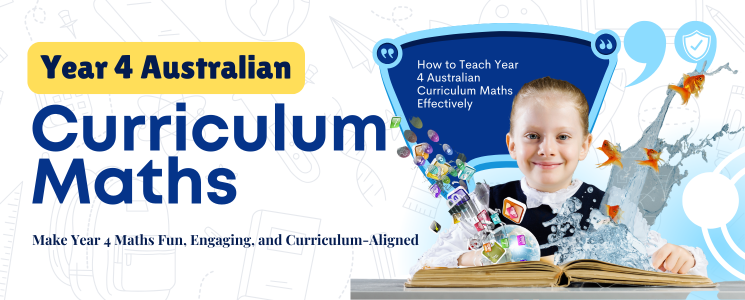Teaching mathematics to Year 4 students can be both rewarding and challenging. The Year 4 Australian Curriculum Maths provides clear learning goals, but turning these goals into engaging classroom activities requires planning, creativity, and effective resources. With the right approach, teachers can inspire a love of maths while ensuring students meet curriculum standards.
Understanding Year 4 Australian Curriculum Maths
The Year 4 Australian Curriculum Maths focuses on helping students develop strong number sense, problem-solving skills, and mathematical reasoning. Topics include whole numbers, fractions, decimals, measurement, geometry, and data interpretation.
At this stage, students are expected to work with larger numbers, understand place value, and apply mathematical operations in real-life contexts. They also learn to interpret data from charts and graphs and begin exploring concepts such as angles and symmetry. Understanding these expectations is the first step toward effective teaching.
By aligning lessons with curriculum outcomes, teachers ensure students gain both foundational skills and confidence in mathematics. Using curriculum-aligned resources makes lesson planning easier and keeps learning consistent and structured.
1. Use Engaging Resources Aligned with the Curriculum
Effective teaching begins with high-quality resources that match the Year 4 Australian Curriculum Maths outcomes. Worksheets, interactive activities, and lesson plans can be adapted to different student needs.
For example, teaching fractions becomes much easier when students can manipulate visual aids like fraction strips or use interactive digital tools. Similarly, worksheets with real-life word problems help students connect maths with daily life, which enhances understanding and retention.
By choosing resources aligned with the curriculum, teachers can save time on planning and focus on delivering engaging lessons. Using both print and digital resources caters to different learning styles and keeps students motivated.
2. Break Down Complex Concepts Into Simple Steps
Many Year 4 students struggle with complex topics such as long division, decimals, or multi-step problem solving. The key to success in teaching Year 4 Australian Curriculum Maths is breaking down concepts into smaller, manageable steps.
For instance, when teaching multiplication of two-digit numbers, start with hands-on activities using objects like counters or blocks. Next, demonstrate step-by-step calculation methods on the board. Finally, allow students to practice with guided worksheets before moving on to independent work.
Using visual aids, manipulatives, and real-life examples makes abstract concepts more concrete. This approach not only helps students understand but also builds their confidence in tackling challenging maths problems.
3. Incorporate Real-Life Applications and Problem Solving
One of the most effective ways to teach Year 4 Australian Curriculum Maths is through real-life applications. When students see how maths applies to everyday situations, they become more engaged and motivated.
For example, teachers can create activities where students plan a small budget for a classroom event. This exercise reinforces addition, subtraction, and multiplication skills while developing practical problem-solving abilities. Measurement activities, such as comparing heights or calculating areas, can be done with objects in the classroom.
Encouraging students to solve real-world problems also helps develop critical thinking and reasoning skills. Teachers should focus on open-ended problems that allow multiple solution strategies. This approach aligns perfectly with the problem-solving focus in the Year 4 curriculum.
4. Encourage Active Participation and Collaborative Learning
Active participation is essential for mastering Year 4 Australian Curriculum Maths. Students learn best when they engage with the material and work collaboratively with peers.
Group activities, math games, and hands-on projects help students develop communication and teamwork skills. For instance, a small group activity might involve creating a bar graph using survey data collected from classmates. Students not only learn to interpret and represent data but also build confidence in sharing ideas and solutions.
Teachers should also encourage students to explain their thinking. Asking questions like “Why did you solve it that way?” or “Can you find another solution?” promotes mathematical reasoning and deeper understanding.
5. Assess and Adapt Learning Approaches
Effective teaching requires ongoing assessment and adaptation. Teachers should regularly check students’ understanding and adjust lessons to meet their needs.
Formative assessments, such as quizzes, class discussions, or exit tickets, help identify areas where students are struggling. If a student finds fractions challenging, the teacher can provide additional hands-on activities or visual aids to reinforce the concept.
Reflecting on teaching methods and outcomes is equally important. Combining assessment with observation allows teachers to adapt resources and activities to maximize student learning. Using curriculum-aligned assessment tools ensures that students meet all learning outcomes for Year 4 Australian Curriculum Maths.
Extra Tips for Teaching Year 4 Australian Curriculum Maths
-
Use Visual Aids and Technology:
Digital tools, interactive whiteboards, and math apps can make lessons more engaging. Visual representations like graphs, charts, and diagrams help students understand abstract concepts.
-
Practice Regularly:
Consistent practice is crucial for reinforcing concepts. Short, daily exercises in addition, multiplication or fractions, improve fluency and confidence.
-
Integrate Storytelling:
Contextualizing maths problems within stories makes learning enjoyable. For example, framing multiplication problems around planning a party or organizing a school trip helps students connect with the content.
-
Celebrate Achievements:
Recognizing student effort and success builds motivation. Praise and encouragement help students develop a positive attitude toward maths.
-
Provide Differentiated Learning:
Tailor activities for diverse learning abilities. Some students may need extra practice, while others can explore advanced challenges. Differentiation ensures all students make progress.
Conclusion
Teaching Year 4 Australian Curriculum Maths effectively requires a combination of high-quality resources, clear explanations, real-life applications, and active student engagement. Breaking down complex concepts, encouraging problem-solving, and incorporating collaborative learning are essential strategies for building confidence and understanding in students.
By using curriculum-aligned resources, teachers can ensure that lessons are engaging, effective, and aligned with national standards. Regular assessment and adaptation enable continuous improvement, ensuring that every student achieves the learning outcomes outlined in the Year 4 curriculum.
With the right approach, teaching Year 4 maths can be both enjoyable and impactful, helping students develop a strong foundation for future mathematical learning and success.


